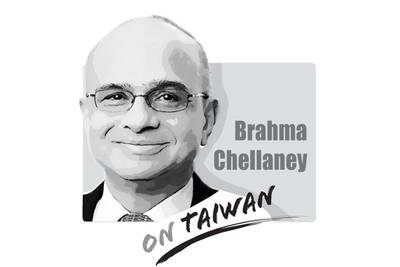China on Monday announced the latest in its efforts to open its markets for Taiwanese companies and investment, saying new 26 measures would more closely reach its ideal of equal treatment between Chinese and Taiwanese “compatriots.”
The 26 measures are basically an extension of the 31 incentives introduced in February last year, and — like those — are clearly an attempt to prime Taiwan for the “one country, two systems” model.
However, the timing of Beijing’s move, a mere two months before the Jan. 11 elections, carries with it a distinct whiff of electoral manipulation.
Is this move wrong-footed, or could it actually work in Beijing’s favor? Is it an act of desperation, an attempt to repeat a technique that worked before, but is doomed to failure in the current international climate?
China’s arms-open approach to Taiwanese business and investment that started in the 1990s worked spectacularly. It helped China soak up Taiwanese capital, technology and talent, and contributed to it becoming the world’s second-largest economy.
China still needs this input, but the situation has changed. Foreign governments are increasingly wary of Beijing’s unfair business practices and the uneven playing field on which overseas companies have to compete with Chinese firms, while the US-China trade dispute and the government’s New Southbound Policy have helped companies and investment migrate out of China, not the other way round.
This is a concern for Beijing, and the new measures are unlikely to go that far in mitigating this trend.
However, the initiative will still work if it affects Taiwan’s elections in the way that Beijing hopes.
The public is well aware of the link between this effort and Beijing’s aim of applying the “one country, two systems” model to Taiwan, and in this regard the timing seems woefully ill-advised.
The Taiwanese were never likely to accept this system, and the ongoing protests in Hong Kong, which are turning darker and more violent by the day, certainly do not make the idea any more palatable.
It will be easy for the Democratic Progressive Party and President Tsai Ing-wen (蔡英文) to exploit this initiative to refocus voters’ attention to the threat that Beijing represents, and in this way its move could be interpreted as a gift to Tsai’s re-election campaign.
That said, the new measures are not explicitly intimidatory: They are all carrot and no stick. Voters already fearful of China’s machinations will not be fooled by them, and they are unlikely to change the way they vote because of them. However, people more favorably disposed to voting for the Chinese Nationalist Party (KMT) and its more pro-China policies might be swayed.
For Tsai’s campaign, a more worrying angle — whether this was Beijing’s intent or not — is how the introduction of economic incentives this close to voting day could shift the focus from the personalities of the candidates to the issues and policies of Tsai and her KMT rival, Kaohsiung Mayor Han Kuo-yu (韓國瑜).
Han’s opinion poll ratings are already falling, mostly because voters perceive him as unreliable, with a penchant for exaggerations, fabrications and unrealistic policy proposals. His campaign has welcomed the new measures.
The Tsai campaign should allow the voters to make up their own minds about Han’s reliability, or lack thereof. He is doing an exemplary job of that unaided. It should concentrate exclusively on Tsai’s policies, vision and achievements, and not risk allowing Beijing to shift the focus of the campaign.
The government and local industries breathed a sigh of relief after Shin Kong Life Insurance Co last week said it would relinquish surface rights for two plots in Taipei’s Beitou District (北投) to Nvidia Corp. The US chip-design giant’s plan to expand its local presence will be crucial for Taiwan to safeguard its core role in the global artificial intelligence (AI) ecosystem and to advance the nation’s AI development. The land in dispute is owned by the Taipei City Government, which in 2021 sold the rights to develop and use the two plots of land, codenamed T17 and T18, to the
US President Donald Trump has announced his eagerness to meet North Korean leader Kim Jong-un while in South Korea for the APEC summit. That implies a possible revival of US-North Korea talks, frozen since 2019. While some would dismiss such a move as appeasement, renewed US engagement with North Korea could benefit Taiwan’s security interests. The long-standing stalemate between Washington and Pyongyang has allowed Beijing to entrench its dominance in the region, creating a myth that only China can “manage” Kim’s rogue nation. That dynamic has allowed Beijing to present itself as an indispensable power broker: extracting concessions from Washington, Seoul
Taiwan’s labor force participation rate among people aged 65 or older was only 9.9 percent for 2023 — far lower than in other advanced countries, Ministry of Labor data showed. The rate is 38.3 percent in South Korea, 25.7 percent in Japan and 31.5 percent in Singapore. On the surface, it might look good that more older adults in Taiwan can retire, but in reality, it reflects policies that make it difficult for elderly people to participate in the labor market. Most workplaces lack age-friendly environments, and few offer retraining programs or flexible job arrangements for employees older than 55. As

Donald Trump’s return to the White House has offered Taiwan a paradoxical mix of reassurance and risk. Trump’s visceral hostility toward China could reinforce deterrence in the Taiwan Strait. Yet his disdain for alliances and penchant for transactional bargaining threaten to erode what Taiwan needs most: a reliable US commitment. Taiwan’s security depends less on US power than on US reliability, but Trump is undermining the latter. Deterrence without credibility is a hollow shield. Trump’s China policy in his second term has oscillated wildly between confrontation and conciliation. One day, he threatens Beijing with “massive” tariffs and calls China America’s “greatest geopolitical